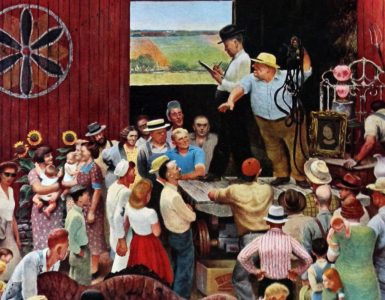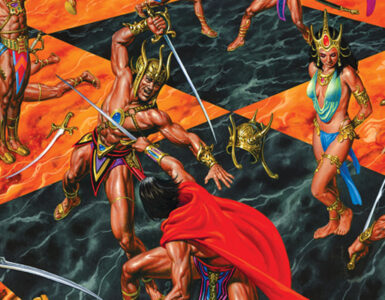Pulp magazines have influenced writers, artists, film directors, software developers, and countless others over the years. Our “PulpFest Profiles” focus on contemporary creators who have drawn inspiration from these rough-paper fiction magazines.
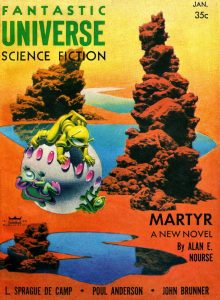
Australian filmmaker, Western Smith had a dream. He wanted to create a science fiction series that was a mash-up between Forbidden Planet and Thunderbirds. The result is Exonauts — an episodic action show where a team of explorers travels to weird, sensational planets and has trippy adventures. Its tongue-in-cheek style is retro-1960’s and the vibe is pure fun. As of this writing, there are two episodes of Exonauts live: “Peril of The Gelatinous Planet” and “A Cavernous Reunion.” Both can be viewed on YouTube. Many more episodes are planned.
I caught up with Western Smith recently about his show, the cast, and how he created some of his gooey special effects. So, settle back, grab a glass of Tang and the remote, and enjoy this fresh glimpse into the wacky world of Exonauts.
Q: Western Smith, you’re Exonauts’ creator. Please tell us a little bit about yourself.
A: I’m twenty-nine years old and live on a peninsula at the bottom of Australia — near Melbourne. I have a home studio where I produce Exonauts. I’ve written music for a lot of bands in the past and released an album of compositions more recently under the name of Chick Vekters. I performed on thirty-five instruments in an Exotica/Musiqué Concrete/Film Score style. That album, Travelogue, was a precursor of sorts to Exonauts, as it was presented as a whimsical audio adventure through unusual terrains. My day job involves mounting ancient artifacts for galleries and museums. We manufacture stands for items, often thousands of years old.
Q: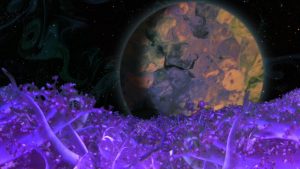 You have mentioned being inspired by the pulps. Please tell us more about this. Did you have a favorite magazine or author?
You have mentioned being inspired by the pulps. Please tell us more about this. Did you have a favorite magazine or author?
A: My pulp inspiration actually comes from the great artwork of the time, more so than the stories themselves. When I started the series I put together a “mood-board” of the best illustrations I could find, to set the tone for myself and the cast. Astounding Science Fiction, Analog, and Galaxy Science Fiction were my main sources. I tried not to draw too much upon the genre at large — consequently retaining a naive palate. My main objective was to make the most unusual sci-fi show I could muster — with as few genre-specific tropes as possible — but also to treat any such devices that arise naturally in science fiction with irreverence.
Even though the series was largely developed by the time I read Olaf Stapleton’s Star Maker (1937), I feel that the author shares similar sentiments to myself in regards to peculiar creature design. It very well may have rubbed off in a way not yet realized. I highly recommend the book to anyone seeking a genuinely awe-inspiring yarn, by the way. Stapleton’s my favorite author in the genre, so far.
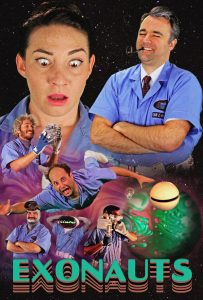 Q: Have you made any other films like Exonauts?
Q: Have you made any other films like Exonauts?
A: This series is my first foray into filmmaking. In retrospect, it’s been an incredibly elaborate project to take on considering I’d never written, directed, or shot anything before, let alone constructed models/props or had any experience in special effects.
With a project like this, it doesn’t take long to realize what you’ve gotten yourself into, especially when confronted with the prospect of every single shot requiring an SFX can of worms to be wrangled into something pleasing, both visually and narratively. But it’s all worth it when you can finally watch the finished product and it is a unique experience.
Q: What inspired you to create Exonauts?
A: After seeing Forbidden Planet (1956) for the first time in 2011, my love of mid-century sci-fi began. So many exoplanets were just being discovered then, which was very intriguing to me. For my own enjoyment, I researched the field heavily — along with numerous celestial and biological curiosities — which evolved into the catalyst of the series.
Jacques Cousteau’s documentaries and films were also a huge influence on me and I sought to parody them with Exonauts. The characters share similar droll personalities of Cousteau and his crew from the 1950s.
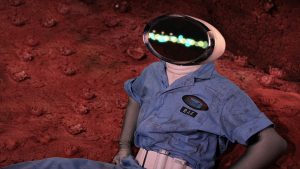 Q: Exonauts has a definite 1950’s/1960’s vibe. What were some of your science fiction inspirations for the show?
Q: Exonauts has a definite 1950’s/1960’s vibe. What were some of your science fiction inspirations for the show?
A: George Pal’s Conquest of Space (1955), Destination Moon (1950), and the Soviet film, Planeta Bur (1962) were some of my early reference material. Chesley Bonestell’s amazing space art and the Disney film, Mars And Beyond (1957) were also big draw cards. The production design for Gerry and Sylvia Anderson’s Thunderbirds & Stingray series influenced the Exonauts world, as did Modernist and Futurist architecture.
Q: Please tell us about your cast members.
A: The cast is made up of friends and family. No one has any past acting experience, which actually makes it a little easier in some ways. It also suits the carefree, tongue-in-cheek demeanor of the Exonauts crew.
M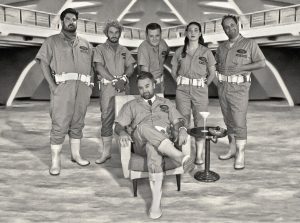 y brother, Lehmann Smith (Hans Albern), is a prolific composer who wrote and produced the “Adventure/Exotica” spiked soundtrack, a very important element of the series. He’s also a music teacher and makes music videos by day.
y brother, Lehmann Smith (Hans Albern), is a prolific composer who wrote and produced the “Adventure/Exotica” spiked soundtrack, a very important element of the series. He’s also a music teacher and makes music videos by day.
James Scullin (Commander J. Mackinaw) is an advisor for diplomatic trade between Australia and China and has just released a book documenting the lavish mid-century styled hotels of North Korea.
Bess Kelly-Norris (Dr. Valerie Serling) is my SFX filming assistant. We also live together and run the artifact mounting business I mentioned previously. Before Covid, she managed one of the longest continuously running pubs in Melbourne.
Jonny Mendelovits (Lester Foundman) is a former history teacher and drummer in a handful of groups. He also played skins on the Exonauts soundtrack.
Glenn Leavold (R.A.E.) makes comedy short films and podcasts, works at a large bookshop, and dabbles in music composition.
Q: How long does it take to produce an episode, including writing, shooting, and post-production?
A: Episodes can take anywhere from one to one and a half years to complete, including both filming and post-production. This doesn’t include all the pre-production and pre-visualization involved in the series’ formation, which began in early 2015. The scripts of the first two episodes went through many iterations before filming started in 2017.
The amount of compositing and post-production in Episode 2 clocks in at roughly 4000-5000 hours. I’m doing everything myself so it’s a lot of work. I’m also somewhat of a perfectionist and spend quite a bit of time getting everything exactly as I want it. If I were to divide those hours by a modest VFX crew of 40, that’s roughly 100 hours work per person—which could be sorted very quickly, funnily enough. Let’s just say it can be quite grueling both physically and mentally for one person to produce, haha.
Q: Your special effects are trippy. Tell us something about how you create them.
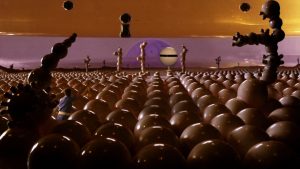 A: Thanks! Generally, I experiment with common items I have on hand. Most of the time, everything comes together nicely on the first try. Planets are created by filling a plate with milk and adding detergent and food dye. The detergent interacts with the fats in the milk and the dye makes this reaction visible, creating some pretty bizarre, swirling undulations.
A: Thanks! Generally, I experiment with common items I have on hand. Most of the time, everything comes together nicely on the first try. Planets are created by filling a plate with milk and adding detergent and food dye. The detergent interacts with the fats in the milk and the dye makes this reaction visible, creating some pretty bizarre, swirling undulations.
Some of the dense atmospheres explored by the crew were created with cooking oil, vinegar, and Alka-Seltzer, resulting in gelatinous seas of varying intensity stacked on top of each other, with the vinegar acting as a barrier separating each layer.
We also have planets and electrical storms derived from the unusual handling of plasma lamps. Chambers and meadows of coral polyps — part of the sentient cave featured in Episode 2 — were composited from footage I shot at the local aquarium.
Q: How many episodes are planned and on what schedule?
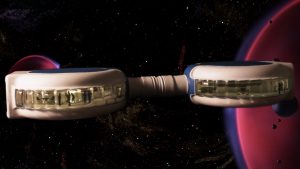 A: I have thirteen episodes planned, but no schedule for them, at the moment. Right now, I’m looking for a suitable production company or broadcaster to work with. Once we have some backing and have moved away from a one-man-crew operation, we’ll be able to release the series on a regular schedule. If anyone has a suitable home for Exonauts in mind, feel free to get in touch.
A: I have thirteen episodes planned, but no schedule for them, at the moment. Right now, I’m looking for a suitable production company or broadcaster to work with. Once we have some backing and have moved away from a one-man-crew operation, we’ll be able to release the series on a regular schedule. If anyone has a suitable home for Exonauts in mind, feel free to get in touch.
Q: Exonauts has appeal for many sci-fi audiences, but who is your ideal audience? In other words, who would you most like to interact with as fans?
A: Fans of Retro-Futurism, vintage sci-fi, and oddball comedy are my main target. But, I’m also keen to interact with as broad an audience as possible. My four-year-old niece loves the show, quoting it with glee and making great fan art. My 83-year-old pen pal Sven Libaek — who was the featured composer on The Life Aquatic, the Inner Space series, and on some Hanna-Barbera cartoons — really enjoys it, as well. I think it works on a broad scale, especially considering that it salutes films and series of the last century while offering elaborate adventures for all ages.
Q: Is there anything else you’d like to mention about Exonauts, yourself, or your crew?
A: Thanks so much for your questions Sara, a pleasure. I hope your readers will check out the show, I think they’ll be pleasantly surprised. It’s the only series exclusively utilizing practical effects and miniatures, with an integrated live-action cast, while fully embracing this underrepresented genre.

Click here for the Exonauts trailer and check out below for a bit more about the first two episodes of Exonauts.
- Episode 1: “Peril of The Gelatinous Planet” — the Exonauts travel to the gelatinous world of Aquaira, on a mission to explore its Southern Hemisphere.
- Episode 2: “A Cavernous Reunion” — the Exonauts explore a sentient cave to collect rare minerals. The highly dangerous cave has particular significance to Commander J. Mackinaw. Then, unexpected danger strikes the team!
You can connect with Exonauts on YouTube, Instagram, or Facebook, or by email at exonauts.series@gmail.com.
Pictured here is the January 1957 issue of FANTASTIC UNIVERSE, featuring cover art by Hannes Bok. The artist’s work can be weird and surrealistic, much like the astounding worlds of Western Smith’s EXONAUTS. Part of the science-fiction explosion of the 1950s, Leo Margulies‘ FANTASTIC UNIVERSE ran for 69 issues and published a mix of science fiction and fantasy.
A professional journalist and illustrator with over thirty years of experience, Sara Light-Waller is an accomplished new-pulp fiction author/illustrator with two books out and more on the way. She is also the winner of the 2020 Cosmos Prize for her illustrated short story, “Battle at Neptune.” A huge pulp fan, Sara is especially fond of science fiction pulps. She is also a member of the PulpFest organizing committee, a regular contributor to our homepage and THE PULPSTER, and often reads for PulpFest‘s “New Fictioneers” program.
Many thanks to Western Smith for speaking with PulpFest and for the production stills used to illustrate his “PulpFest Profile.” We’ll be visiting with another contemporary creator profile in mid-February. We hope you’ll join us.



